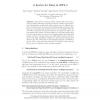167
Voted
COMAD
2009
15 years 1 months ago
2009
An ontology is an explicit specification of shared conceptualization. The Web Ontology Language (OWL) is a family of knowledge representation languages for authoring ontologies, a...
102
click to vote
SWWS
2008
15 years 2 months ago
2008
We propose a set of metrics for measuring the semantic implications of changes during ontology evolution. Our metrics focus on the changes of classes and associated axioms or annot...
128
click to vote
OWLED
2008
15 years 2 months ago
2008
In this paper we present the basic requirements and initial design of a system which manages and facilitates changes to an OWL ontology in a multi-editor environment. This system u...
ESWS
2006
Springer
15 years 4 months ago
2006
Springer
Abstract. In this paper, we investigate the problem of repairing unsatisfiable concepts in an OWL ontology in detail, keeping in mind the user perspective as much as possible. We f...
107
Voted
SEKE
2004
Springer
15 years 6 months ago
2004
Springer
We present an approach for mapping an OWL ontology into Java. The basic idea is to create a set of Java interfaces and classes from an OWL ontology such that an instance of a Java ...
101
Voted
RULEML
2005
Springer
15 years 6 months ago
2005
Springer
Abstract. When developing situation awareness applications we begin by constructing an OWL ontology to capture a language of discourse for the domain of interest. Such an ontology,...
108
Voted
ESWS
2007
Springer
15 years 7 months ago
2007
Springer
Abstract. Ontologies are now used within an increasing number of realworld applications. So far, significant effort has been spend in building tools to support users in creating,...
144
click to vote
CSSE
2008
IEEE
15 years 7 months ago
2008
IEEE
—At present, Web services are created and updated on the fly. It has already beyond the human ability to analysis them and generate the composition plan manually. It is a problem...
108
Voted
SACMAT
2009
ACM
15 years 7 months ago
2009
ACM
XACML does not natively support RBAC and even the specialized XACML profiles are not able to support many relevant constraints such as static and dynamic separation of duty. Exte...
103
Voted
SEMWEB
2009
Springer
15 years 7 months ago
2009
Springer
Being able to extend an OWL ontology with some form of rules is a feature that many ontology developers consider as very important. Nevertheless, working with rules in practice can...





